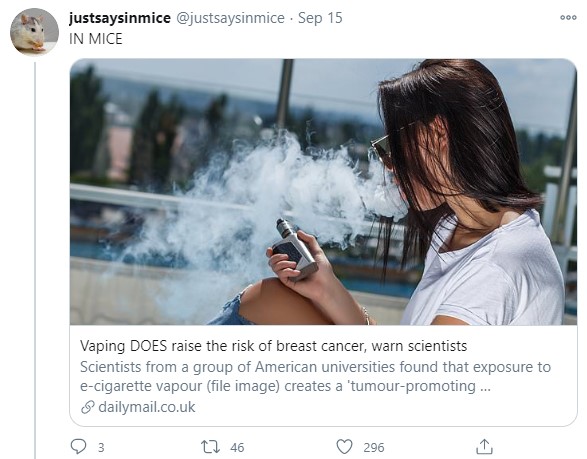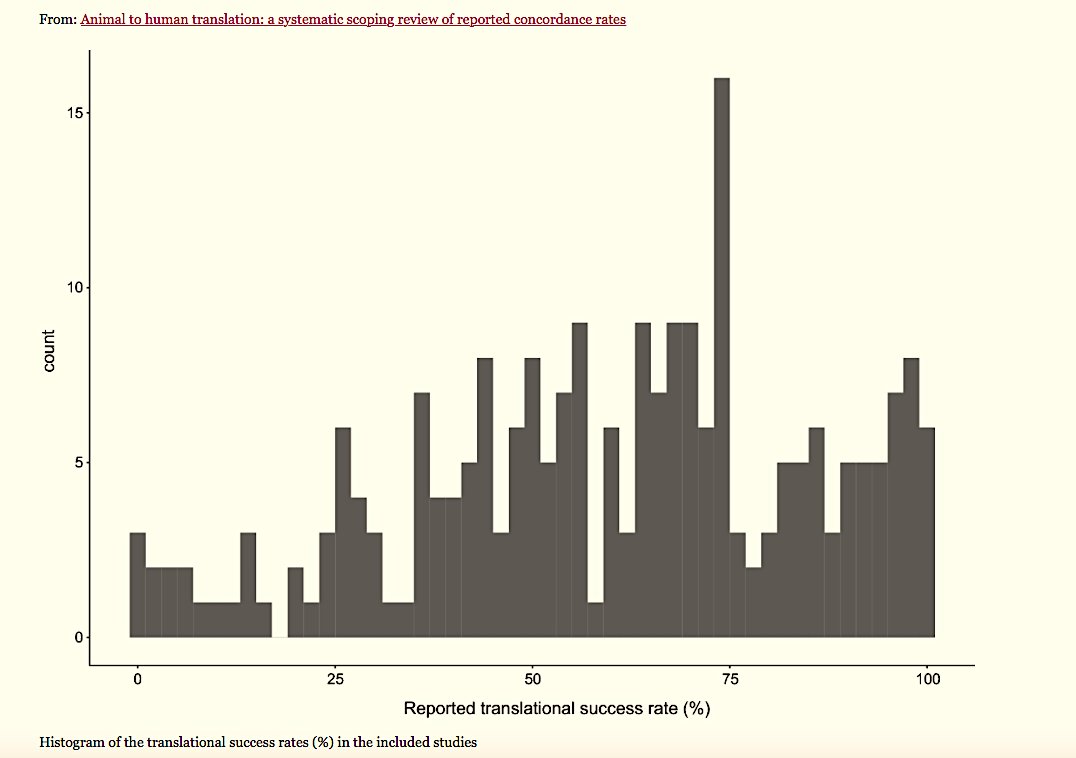And if you use mice, it's truly open season on science the public can trust. An entire Twitter feed just basically adds "in mice" onto the end of provocative claims that researchers and journalists fail to note and it's wildly popular among scientists who recognize that doing so erodes trust in all science - such as the immunology important during the COVID-19 pandemic.

Like statistical correlation, mouse studies are to be placed firmly over the in "exploratory" section of science. They may be interesting, they may be worth a follow-up, but they have no human relevance until science shows it. That is why all of the ~200 COVID-19 vaccine candidates will not get FDA emergency authorization based on mouse studies or epidemiology. Those two things can only exclude a positive or negative effect in humans, they cannot show either; biology and chemistry still rule.
Here is how poorly animal studies translate to anything clinical - under 10 percent. And for epidemiology, it's even less relevant, unless you are in a trade group claiming red meat either causes or prevents cancer, both of which have been shown statistically.

Yet if you want to get media attention from corporate journalists, epidemiology and mouse studies are the way to go. You just make some bizarre claim, like that your living room is causing diabetes, and you will get attention.(1)
A recent paper in Scientific Reports does just that.(2) They "suggest" - because they did no science to show it - that polybrominated diphenyl ethers (a combination of PBDEs in DE-71) in furniture are causing diabetes in humans. Not type 1 diabetes, obviously, but rather the lifestyle form of type 2 diabetes - the one that almost overwhelmingly occurs among obese people. History is not on their side. Brominated flame retardants like PBDEs were used by the ancient Romans to keep their expensive siege towers from being set on fire. We have no evidence any soldiers thought their siege towers were causing obesity. England even issued the first patent for a chemical flame retardant in 1735 and in nearly 300 years no surge in type 2 diabetes happened due to it.
The concept of flame retardation is simple. You have probably heard terms like "oxidation" and "free radicals" when it comes to biology - we burn food to create energy - and PBDEs are like antioxidants that suppress the free radicals, because chemicals that contain multiple atoms of bromine and chlorine don't burn very well. They slow the combustion process or prevent fire entirely, which makes furniture much safer. PBDEs were once popularly sprayed onto furniture to prevent "flashover" during a fire thanks to California. Specifically, California flammability standard Technical Bulletin 11 from 1975, which mandated them, and soon the rest of the country wanted the science California consumers were able to get.
And it worked. If you ask an older firefighter what they once feared most, it was flashover - when heat caused things to decompose (pyrolysis), emitting flammable gases that then exploded inside rooms. Flame retardants on furniture caused deaths during house fires, including by firefighters, to plummet.
Yet the world of the 1990s was a lot more scientifically naïve than today. We were not yet jaded by $2 billion in lawyer-driven environmental groups that have to create new problems - PM2.5, formaldehyde, BPA, you name it and someone calls it an "endocrine disruptor" - to get us worried about or they are out of business. And by the 1990s activists were in full force claiming these trace chemicals were harmful - using high exposures in mice and epidemiological correlation. By 2004, PBDEs were out of furniture again for the same reason BPA stopped being used in Manwich cans a few years ago; science is irrelevant when chemophobia in media overrules it. “EPA has not concluded that PBDEs pose an unreasonable risk to human health or the environment,” EPA wrote, but the writing was also on the marketing wall. Anti-science activists had won and reason had to go.
Yet activists are in a war of extinction against science so the argument then went from 'you should remove these chemicals because the public are worried' to 'the chemicals must have been toxic or companies would not have removed them' and that continues today. The argument now is that these chemicals "persist" in the environment, they can even create homeopathic magic and waft a molecule from landfills, it seems, and still cause effects. Statistical correlation can accomplish anything so there have been papers claiming that they are "linked" to lower IQ and behavioral problems in kids, breast cancer in women - all without showing any evidence.
In the new paper, the researchers exposed mice to levels of DE-71 orders of magnitude higher than possible in the real world and unsurprisingly found that mice pups got them in the womb and then through mother's milk. It is no surprise to a chemist, a toxicologist, or a biologist that the offspring developed symptoms of mouse versions of "pre"-diabetes. It would be shocking if they hadn't.
Yet though this work does nothing at all to inform clinical relevance - mice are not simply smaller people(3) - the authors still say overdosing mice on chemicals that haven't been used in 17 years means they should get paid to conduct longitudinal studies in humans to see if babies exposed to PBDEs. Well, all of us can be shown to have been exposed, since we can detect anything in anything, and many of us will go on to develop type 2 diabetes; because obesity is another common condition that can be blamed on science. Agriculture science has succeeded so well that for the first time in human history even the poorest people can afford to be fat.
This does not mean we should revert to the old ways and have mass famine and starvation. And the last thing firefighters want is more people dying in fires so environmentalists can say they won.
NOTES:
(1) You can show statistical significance for nearly any speculation. It's easy. I can show, with statistical significance, that coin flips are prejudiced against heads. Or tails. You just need enough data and a desire to only see the result you want.
(2) Macmillan, the parent of both Nature and Scientific American, and itself owned by the German family group Verlagsgruppe Georg von Holtzbrinck GmbH, lost its way scientifically earlier this century and it's only gotten worse. This year they even started officially endorsing Democrat politicians - but their work has been "anti"science when it comes to chemicals - in line with Democratic beliefs about science - for much longer. When the Vice-President Elect declared she would not trust any vaccine authorized by the FDA during the Trump administration, we can expect more regulations without evidence, more endorsement of organic food, and more of the anti-vaccine sentiment that is dominated by the left.
(3) Mice are closer to humans than bananas (60% common DNA) at 85%, though. But claiming bananas got diabetes won't get you in the New York Times and for some reason mice will.





Comments